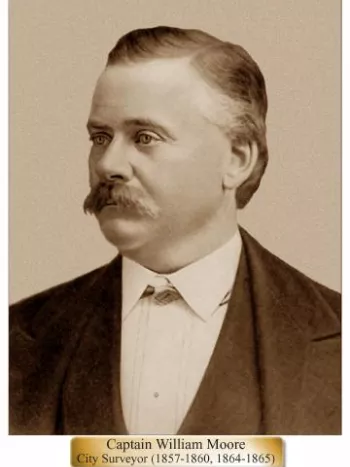
William Moore was born April 3, 1827 in Augusta, Maine where his family were farmers and linen weavers. In his youth he learned the carriage raking trade and by the age of 21 was manufacturing carriages, buggies, and sleighs in Lewiston Falls, Maine.
On July 4, 1852, he sailed from New York around the Horn for California. After spending eighteen months in the mining and lumber regions near Napa, California, he decided to relocate in Southern California. Since steamer service of that day between San Francisco and Los Angeles was irregular and largely unscheduled, Mr. Moore decided to walk to Los Angeles, arriving there on his 27th birthday April 3 in 1854. Here, he worked a short time at carriage making until applying himself to surveying, a profession he would pursue for the rest of his life.
He was first associated with George Hansen, pioneer city surveyor and engineer, in a professional association and warm personal friendship that was to last a lifetime. Captain Moore seemed to hold the office of City Surveyor almost interchangeable with Mr. Hansen between 1857 and 1875. He was City Surveyor from 1857 to 1860, 1864 to 1865, and 1873 to 1875. He also served concurrently as superintendent of Streets for a part of the time and is credited with standardizing, straightening, and leveling the uniform grade the sidewalks of the City.
As a surveyor, he laid out ditches, reservoirs and tunnels, and aided in establishing the city's first sewage system. At one time or another, he is said to have surveyed nearly every foot of land in Los Angeles County. It is known he spent about forty three years of his private and public life surveying old Spanish grants, ranchos, county and city property, and examining old and new records and boundaries.
So much an authority he became and so trusted was his personal probity that his expert testimony was frequently taken in courts of law without an Oath being required.
A man of wit and humor, with quaint expressions, he was both a scholar and linguist who could converse with the old timers of the City in Spanish or in many other tongues.
His wife, whom he married in the home of General Volney Howard in San Gabriel, in the presence of George Hansen and Prudent Beaudry, was also an early Los Angeles pioneer. As a girl of sixteen years, Mrs. Moore came to California with her mother, via the Isthmus of Panama to San Francisco, thence to Los Angeles by stagecoach. Mother and daughter homesteaded government land in 1865, a parcel of which at Western and Adams, is still in possession of the latter's children (As of 1937).
At the beginning of the Civil War he was appointed Captain of a company of California infantry, and later organized and drilled a military unit which became a home guard unit. Both Captain and Mrs. Moore were prominent factors in the early social life of Los Angeles. "Captain Willie's Company" of home guards served as, a famous old time social and recreational organization in the early days.
Captain Moore remained active in the practice of his profession until a short time before his last illness. He died January 11, 1897.
During the years Moore was Surveyor/Engineer, one square mile of land was annexed to Los Angeles on the south, the first of a series of annexations. Telegraph service began, connecting Los Angeles with San Francisco and the rest of the nation.
While Moore was Pro-Union, Los Angeles was emphatically in sympathy with the South. So much so that on April 17, 1865, after openly rejoicing over news of the assassination of Abraham Lincoln, cooler heads prevailed and Council approved a resolution for a memorial service to be held in his honor two days later.
In 1874, the first city "railroad", the Spring and Sixth Street streetcar line two thousand miles long and horse drawn, was built and partially subsidized by owners of property along the line.